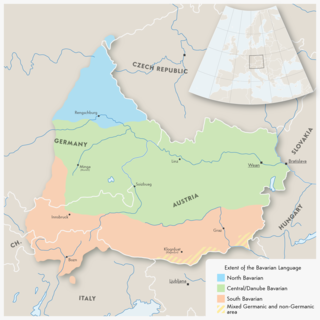
Back Beiers Afrikaans Bairisch ALS Idioma bavaro AN البافارية Arabic Idioma austrobávaru AST Bavariya dili Azerbaijani Boarisch BAR Баварскі дыялект Byelorussian Баварскі дыялект BE-X-OLD Австро-баварски диалекти Bulgarian
This article needs additional citations for verification. (February 2010) |
| Bavarian | |
|---|---|
| Austro-Bavarian | |
| Boarisch / Boirisch | |
 Parking sign in Munich | |
| Region | Bavaria (Germany) Austria South Tyrol (Italy) |
| Ethnicity | Bavarians Austrians South Tyroleans |
Native speakers | 15 million (2012)[1] |
| Dialects | |
| Latin alphabet, Marcomannic (historically) | |
| Language codes | |
| ISO 639-3 | bar |
| Glottolog | baye1239 Bairischbava1246 Bavarian |
 Extent of Bavarian | |
 Bavarian is classified as Vulnerable by the UNESCO Atlas of the World's Languages in Danger | |

Bavarian (German: Bairisch [ˈbaɪʁɪʃ] ; Bavarian: Boarisch, Boirisch[2]), alternately Austro-Bavarian, is a major group of Upper German varieties spoken in the south-east of the German language area, including the German state of Bavaria, most of Austria and the Italian region of South Tyrol.[3] Prior to 1945, Bavarian was also prevalent in parts of the southern Sudetenland and western Hungary.[4] Bavarian is spoken by approximately 12 million people in an area of around 125,000 square kilometres (48,000 sq mi), making it the largest of all German dialects. In 2008, 45 percent of Bavarians claimed to use only dialect in everyday communication.[5]
- ^ Bavarian at Ethnologue (26th ed., 2023)

- ^ Rowley, Anthony R. (2023). Boarisch – Boirisch – Bairisch: Eine Sprachgeschichte (in German). Friedrich Pustet GmbH & Co. KG. ISBN 9783791734378.
- ^ Rowley 2011, p. 300.
- ^ "Bavarian". Ethnologue. Retrieved 2017-08-31.
- ^ Rowley 2011.